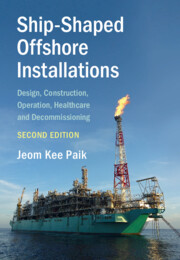Book contents
- Ship-Shaped Offshore Installations
- Cambridge Ocean Technology Series
- Ship-Shaped Offshore Installations
- Copyright page
- Contents
- Preface to the Second Edition
- Preface to the First Edition
- 1 Introduction to Ship-Shaped Offshore Installations
- 2 Structural Steel Selection and Construction
- 3 Ocean Environmental Conditions
- 4 Site-Specific Wave-Induced Hull Girder Loads
- 5 Serviceability Limit States
- 6 Fatigue Limit States
- 7 Ultimate Limit States
- 8 Accidental Limit States
- 9 Mooring System Engineering
- 10 Sloshing Impact Engineering
- 11 Seismic Impact Engineering
- 12 Aircraft Impact Engineering
- 13 Quantitative Risk Assessment and Management
- 14 Life-Cycle Corrosion Assessment and Management
- 15 Lifetime Healthcare and Safe Decommissioning
- Book part
- Index
- References
2 - Structural Steel Selection and Construction
Published online by Cambridge University Press: 27 January 2022
- Ship-Shaped Offshore Installations
- Cambridge Ocean Technology Series
- Ship-Shaped Offshore Installations
- Copyright page
- Contents
- Preface to the Second Edition
- Preface to the First Edition
- 1 Introduction to Ship-Shaped Offshore Installations
- 2 Structural Steel Selection and Construction
- 3 Ocean Environmental Conditions
- 4 Site-Specific Wave-Induced Hull Girder Loads
- 5 Serviceability Limit States
- 6 Fatigue Limit States
- 7 Ultimate Limit States
- 8 Accidental Limit States
- 9 Mooring System Engineering
- 10 Sloshing Impact Engineering
- 11 Seismic Impact Engineering
- 12 Aircraft Impact Engineering
- 13 Quantitative Risk Assessment and Management
- 14 Life-Cycle Corrosion Assessment and Management
- 15 Lifetime Healthcare and Safe Decommissioning
- Book part
- Index
- References
Summary
Classification society rules or recommended practices dictate the types of steel to be used in the assembly of the hull structures of ship-shaped offshore installations. The steel must exhibit high levels of buckling and fatigue performance and be amenable to corrosion management. It is recommended that the proportion of reduced thickness, high strength steel be minimised and the proportion of ordinary steel (e.g., grade A) be maximised in a hull structure. However, structural members that require an ordinary steel plate with a thickness greater than 30 mm may instead be made from high strength steel to avoid the need for heavy welding and to simplify the construction. The greater resistance of high strength steel to corrosion reduces the need for repairs in dry dock, which is critical for the long on site life required in a ship-shaped offshore installation. Three grades of steel are used in the assembly of hulls for installations that will be in service at sub-zero temperatures: grade D steel for use at −20°C, grade E steel for use at −40°C and grade F steel for use at −60°C. Steel may be exposed to colder temperatures than it has been designed to withstand or even to cryogenic conditions as a result of the accidental release of liquefied gas (e.g., liquefied natural gas or hydrogen). This can cause a brittle fracture in structural steel and a subsequent catastrophic failure.
- Type
- Chapter
- Information
- Ship-Shaped Offshore InstallationsDesign, Construction, Operation, Healthcare and Decommissioning, pp. 49 - 80Publisher: Cambridge University PressPrint publication year: 2022

